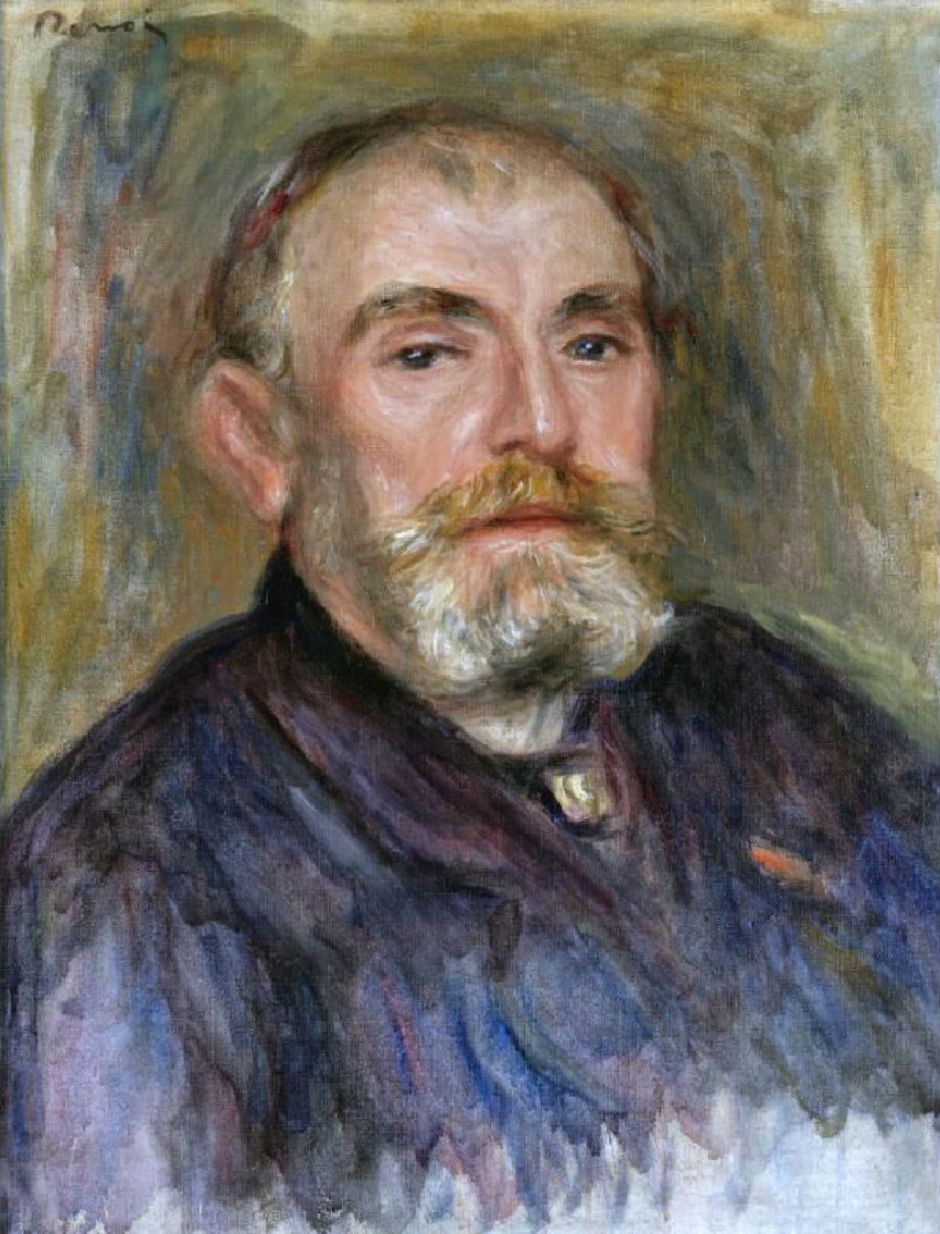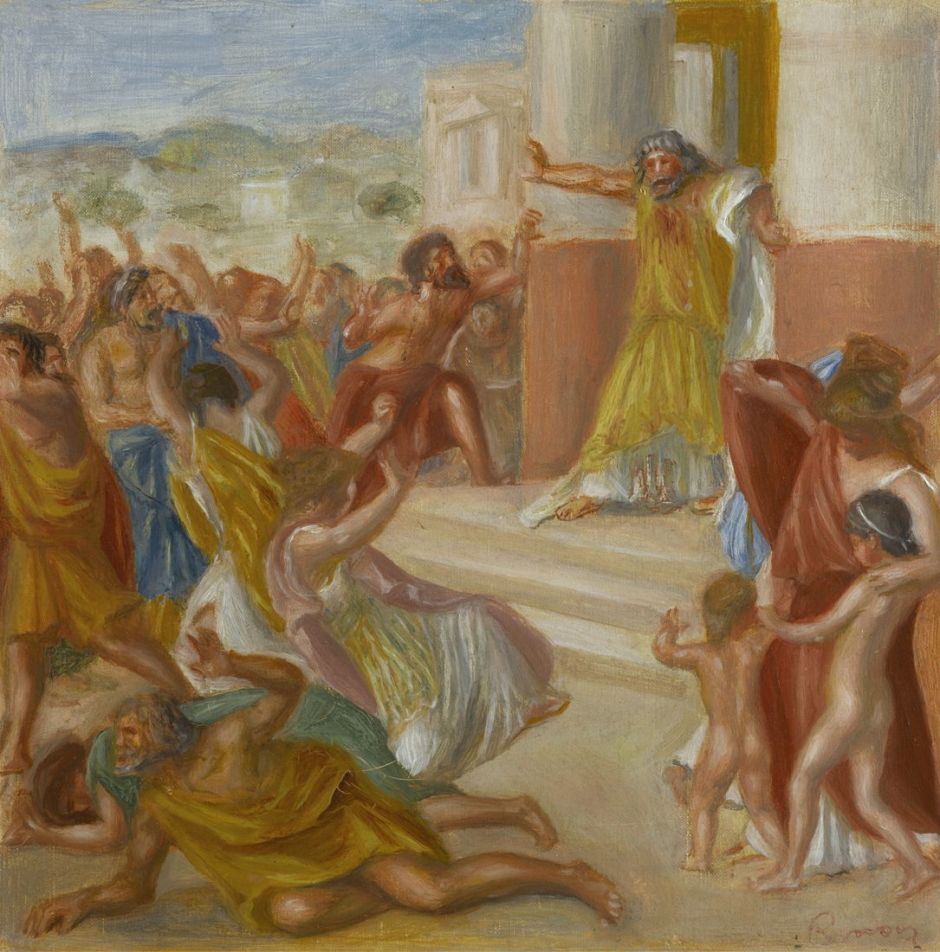After Renoir’s failed attempt to develop a new style of figurative painting in the mid-1880s, the style of his paintings had settled back to please his dealer and collectors again by the early 1890s. His landscapes continued to be more experimental, following two visits to paint alongside Paul Cézanne at Aix-en-Provence.

In addition to his portraiture work, Renoir is well-known for his many paintings of nudes. This Bather from 1891 is typical of the many which he made at this time: soft-focus and delicately fleshly, against a background of brushstrokes of gently brilliant colours.

The landscape takes precedence in this painting of The Laundress, also from 1891. It’s interesting to see that Renoir has used Cézanne’s technique of outlining branches using dark contours, in the bush in the right foreground. Coupled with flattening of depth and more even areas of colour, this became more dominant in Cloisonnism, a term which had only just been coined in 1888, and was becoming characteristic of Gauguin and his school at Pont-Aven.
In 1891, Remoir travelled within France, spending the summer with his family in Mézy, on the River Seine to the north-west of Paris. Durand-Ruel paid him 7,500 Francs each for three paintings of couples dancing, indicative of his growing commercial success.
The following year, Durand-Ruel organised Renoir’s largest solo exhibition to date, in which over a hundred of his paintings were on display. Among the most important purchases of his work was one for the French nation, which confirmed the security of his future. He made two important visits that year too: he studied paintings of the Masters in Madrid’s Prado gallery, and visited the thriving artists’ colony in Pont-Aven in Brittany.

His portraits of girls and young women, either reading or these Young Girls at the Piano (1892), were also characteristically soft focus and gentle.

Renoir’s landscapes continued to develop during this period. He painted Bois de la Chaise (Noirmoutier) in 1892, on a small island joined to the north coast of the Bay of Biscay by a tidal causeway, which he must have visited when in Brittany during that summer. Its mimosa trees appear to melt into the warmth of the sky, and there’s now no trace of dark contours in their branches.

Despite his arthritis, Renoir still seems to have painted plein air oil sketches, such as this marvellous View From Montmartre from about 1892. He has adapted Cézanne’s constructive strokes, particularly in the sky.
In 1893, Renoir spent more time in the warmth of the south of France, presumably in an effort to ease his arthritis. Then in the heat of the summer, he took his family to Pont-Aven in Brittany.

In Picnic, with the original French title of Le Déjeuner sur l’herbe, from about 1893, he explores the rich effects of dappled light. This work also plays tricks with the viewer: two standing figures to the left come and go as you look at them. Or are they just patterns in the trees and their foliage?

Renoir’s Landscape at Beaulieu from about 1893 is more traditionally Impressionist, with stronger form among its leaves.
Gustave Caillebotte died in 1894, and Renoir was appointed his executor, which proved an impossible task. Caillebotte wanted his superb collection of Impressionist paintings to go to a major collection, but (incredibly) all refused. Renoir made his first contacts with the art dealer Ambroise Vollard. However, his arthritis was particularly bad that year, and he had to take to thermal baths to try and ease his symptoms. He started having to walk on crutches because of its effects on the joints in his legs.

Renoir had developed a good friendship with Berthe Morisot and Her Daughter, Julie Manet, seen here in his double portrait from 1894. Morisot suffered chronic ill health from the time of the Franco-Prussian War. When Renoir painted her here she was only 53. When she died on 2 March the following year (1895), Renoir returned from wintering in Provence to attend her funeral in Paris. Julie’s father Eugène (brother of the painter Édouard Manet) had died three years earlier, leaving her orphaned at the age of sixteen.
At the end of 1895, Renoir and Cézanne broke off their longstanding friendship.

Renoir was also a good friend of Henry Lerolle and his family. Like Caillebotte, Lerolle was relatively affluent, and an enthusiastic painter himself. He too had a fine collection of Impressionist paintings, and was a significant patron as well as a collector. Lerolle himself didn’t paint in Impressionist style, but was a Naturalist: this article considers his masterpiece, other paintings, and his collection.

Henry Lerolle’s older daughter was the model for Renoir’s Christine Lerolle Embroidering from about 1895. She is working with an embroidery frame made of bamboo. Christine would have been eighteen at the time that this was painted, and was already a favourite of Renoir’s. In the background, her father and a friend are studying one of the paintings in the family collection.

At some stage in 1895, Renoir seems to have visited the lower end of the Bay of Biscay, where he painted this superb plein air oil sketch of Fishing Port, View of Fontarabie from Hendaye (1895). Fontarabie refers to what is now known as Hondarribia, on the coast of the Basque Country.

In 1895, Renoir was commissioned by Paul Gallimard (the patron who had accompanied him to Madrid in 1892) to make a series of paintings for his homes in Paris and Normandy. Among those works was Oedipus Rex (1895), one of Renoir’s few narrative paintings. This shows the famous actor of the time Jean Mounet-Sully (1841-1916) in the title role after his character had gouged his own eyes out, and is stumbling out of his palace to confront the Thebans and demand his own exile.
This commission was abandoned incomplete, and Renoir retained the paintings in his studio until his death.

On 15 September 1894, the artist’s son Jean was born. He is shown here with Gabrielle Renard (Renoir’s wife Aline’s cousin), who was employed by the family as a nanny, and had become Renoir’s favourite model. Gabrielle and Jean from 1895-96 is a very personal depiction of the artist’s young son at play with wooden animals. Jean Renoir (1894-1979) went on to become almost as well-known as his father, as a major film director.
References

